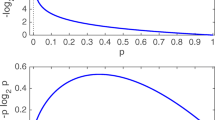Abstract
The entropy of earthquakes is derived by using the Gutenberg–Richter statistical distributions. Both canonical and microcanonical earthquake distributions are given, and Einstein’s fluctuation formula is deduced for earthquakes. The seismic activity of Vrancea in the period 1980–2019 is analyzed, for earthquakes with magnitude greater than two, and the results are compared with the theoretical results. It is shown that the parameter of the magnitude distribution exhibits a tendency of increasing with time, due to the accumulation of small-magnitude earthquakes, interrupted from time to time by ruptures towards smaller values, caused by earthquakes with greater magnitudes. These variations do not obey the normal distribution of the fluctuations. The (small) time variations of the distribution parameter provide a measure of the departure of the seismic activity from an equilibrium process. For Vrancea, these deviations are very small (up to 1% per year).


Similar content being viewed by others
References
Abramowitz M, Stegun IA (1964) Handbook of mathematical functions, with formulas, graphs and mathematical tables. National Bureau of Standards, Applied Mathematics Series #55, Washington, DC, p 806
Apostol BF (2020) Bath’s law, correlations and magnitude distributions. arXiv:2006.07591v1 [physics.geo-ph], 13 June
Apostol BF (2006a) A model of seismic focus and related statistical distributions of earthquakes. Rom Reps Phys 58:583–600
Apostol BF (2006b) Model of seismic focus and related statistical distributions of earthquakes. Phys Lett A 357:462–466
Apostol BF (2019a) An inverse problem in seismology: derivation of the seismic source parameters from P an S seismic waves. J Seismol 23:1017–1030
Apostol BF (2019b) Statistical seismology, internal report. Institute of Earth’s Physics, Magurele
Berrill JB, Davis RO (1980) Maximum entropy and the magnitude distribution. Bull Seismol Soc Am 70:1823–1831
Bullen KE (1963) An introduction to the theory of seismology. Cambridge University Press, London
Console R, Lombardi AM, Murru M, Rhoades D (2003) Bath’s law and the self-similarity of earthquakes. J Geophys Res 108:2128. https://doi.org/10.1029/2001JB001651
De Santis A, Cianchini G, Favali P, Beranzoli L, Boschi E (2011) The Gutenberg–Richter law and entropy of earthquakes: two case studies in Central Italy. Bull Sesimol Soc Am 101:1386–1395
De Santis A, Abbattista C, Alfonsi L, Amoruso L, Campuzano SA, Carbone M, Cesaroni C, Cianchini G, De Franceschi G, De Santis A, Di Giovambattista R, Marchetti D, Martino L, Perrone L, Piscini A, Rainone ML, Soldani M, Spogli L, Santoro F (2019) Geosystemics view of earthquakes. Entropy 21:412. https://doi.org/10.3390/e21040412
Dong WM, Bao AB, Shah HC (1984) Use of maximum entropy principle in earthquake recurrence relationships. Bull Seismol Soc Am 74:725–737
Einstein A (1909) Zum gegenwaertigen Stand des Strahlungsproblem. Phys Z 10:185–193
Gibbs JW (1902) Elementary principles in statistical mechanics. Scribner’s sons, New York
Gulia L, Wiemer S (2019) Real-time discrimination of earthquake foreshocks and aftershocks. Nature 574:193–199
Gutenberg B, Richter C (1944) Frequency of earthquakes in California. Bull Seismol Soc Am 34:185–188
Gutenberg B, Richter C (1956) Magnitude and energy of earthquakes. Ann Geofis 9: 1–15 ((2010) Ann Geophys 53:7–12)
Hanks TC, Kanamori H (1979) A moment magnitude scale. J Geophys Res 84:2348–2350
Kanamori H (1977) The energy release in earthquakes. J Geophys Res 82:2981–2987
Kisslinger C (1996) Aftershocks and fault-zone properties. Adv Geophys 38:1–36
Landau L, Lifshitz E (1980) Statistical physics, course of theoretical physics, vol 5. Elsevier, Oxford
Lay T, Wallace TC (1995) Modern global seismology. Academic Press, San Diego
Lombardi AM (2002) Probability interpretation of “Bath’s law”. Ann Geophys 45:455–472
Main I, Al-Kindy F (2002) Entropy, energy and proximity to criticality in global earthquake populations. Geophys Res Lett. https://doi.org/10.1029/2001GL014078
Main I, Burton PW (1984) Information theory and the earthquake frequency-magnitude distribution. Bull Seismol Soc Am 74:1409–1426
Marzocchi W, Sandri L (2003) A review and new insights on the estimation of the \(b\)-value and its uncertainty. Ann Geophys 46:1271–1282
Masinha L, Shen PY (1987) On the magnitude entropy of earthquakes. Tectonophysics 138:115–119
Nicholson T, Sambridge M, Gudmundsson O (2000) On entropy and clustering in earthquake hypocentre distributions. Geophys J Int 142:37–51
Ranalli G (1969) A statistical study of aftershock sequences. Ann Geofis 22:359–397
Richter CF (1958) Elementary seismology. Freeman, San Francisco
Romanian Earthquake Catalogue (ROMPLUS Catalog), National Institute for Earth Physics, Romania (2018) (updated)
Shannon CE (1948) A mathematical theory of communication. Bell Syst Tech J 27(379–423):623–666
Shen PY, Mansinha L (1983) On the principle of maximum entropy and the earthquake frequency-magnitude relation. Geophys J R Astr Soc 74:777–785
Stein S, Wysession M (2003) An introduction to seismology, earthquakes, and earth structure. Blackwell, New York
Udias A (1999) Principles of seismology. Cambridge University Press, New York
Utsu T (1969) Aftershocks and earthquake statistics (I, II): Source parameters which characterize an aftershock sequence and their interrelations. J Fac Sci Hokkaido Univ Ser VII 3:129–195
Utsu T, Seki A (1955) A relation between the area of aftershock region and the energy of the mainshock. J Seismol Soc Jpn 7:233 (in Japanese)
Wiener N (1948) Cybernetics. MIT Press, Cambridge
Acknowledgements
The authors are indebted to the colleagues in the Institute of Earth’s Physics, Magurele-Bucharest, for many enlightening discussions, and to the anonymous Reviewers for thoughtful suggestions. This work was partially carried out within the Program Nucleu 2019, funded by Romanian Ministry of Research and Innovation, Research Grant #PN19-08-01-02/2019.
Author information
Authors and Affiliations
Corresponding author
Additional information
Communicated by Ramon Zuñiga, Ph.D. (CO-EDITOR-IN-CHIEF).
Rights and permissions
About this article
Cite this article
Apostol, B.F., Cune, L.C. Entropy of earthquakes: application to Vrancea earthquakes. Acta Geophys. 69, 395–404 (2021). https://doi.org/10.1007/s11600-021-00550-4
Received:
Accepted:
Published:
Issue Date:
DOI: https://doi.org/10.1007/s11600-021-00550-4




